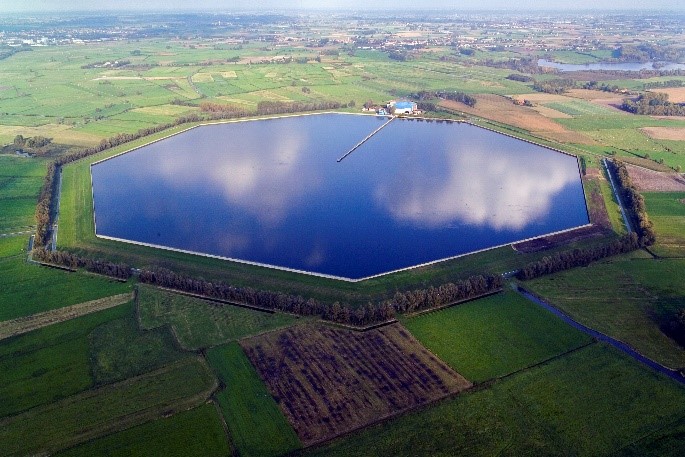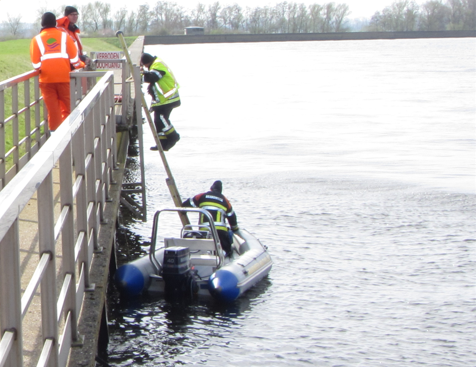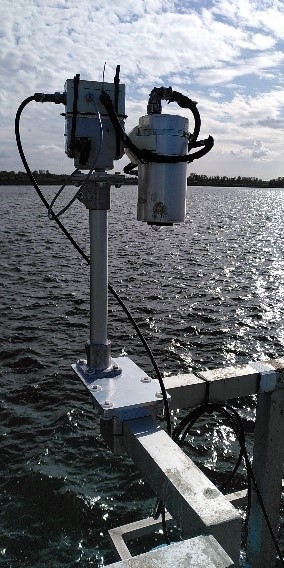Project Description
De Watergroep delivers drinking water to more than 3 million customers in Flanders, Belgium. Both groundwater and surface water are used as a raw source for drinking water production, depending on the availability in the region where production is required. In the west of Flanders, the geology doesn’t allow to extract groundwater in large quantities from the soil. Therefore, surface water from rivers is used. Unfortunately, the availability of surface water fluctuates throughout the year due to the climatological summer-winter conditions. Reservoirs have been built in the 1970s to collect and store surface water to overcome dry periods or periods of inferior water quality in the rivers due to drought or pollution events.
The water production center of “De Blankaart” can produce up to 40 million liters of drinking water each day. To safeguard this potential, an octagonal reservoir was built that can store 3 million m3 of water from 2 nearby surface water streams. Since the catchment of both rivers is located in a farming area, the water that is pumped to the reservoir is very rich in nutrients such as nitrogen and phosphates. The excess of nutrients in the water causes harmful algae blooms to occur in the reservoir in the summer period, when warmer weather and high light intensity favor the growth of cyanobacteria, also known as blue-green algae because of their appearance. These algae blooms can cause problems in the different steps in the process of producing drinking water quality, and require an increased use of chemicals and/or rinsing water. Furthermore, the demand for drinking water from the distribution net is high in these warm and sunny periods, with algae blooms putting an extra stress on the drinking water supply.

Figure 1: “De Blankaart” water production center.
The water quality in the reservoir is continuously monitored at the intake and regularly sampled at both the inlet and outlet side of the reservoir. Sampling the water at different locations in the reservoir necessitates a boat, complicating the process. As such, De Watergroep currently lacks spatially distributed data about algae presence in the reservoir. The surface area of the reservoir is 60ha and due to currents induced by changing winds, the location of development and concentrations of algae is very variable. To ensure timely measures are taken to control the algae bloom, an early warning system is needed that can monitor the algae concentrations in a spatially distributed way and that can distinguish between the different groups of algae (green, blue-green and diatoms).

Figure 2: Water sampling process using a boat.
In the CALLISTO project, data from an online hyperspectral camera of RBINS, mounted on a wall in the reservoir, is used to finetune a correction algorithm. This algorithm converts the information obtained from satellite data to concentrations of different algae types at all locations in the reservoir. The algae contain various pigments such as different types of chlorophyll and phycocyanin. Since the latter is only present in blue-green algae, the difference in estimated concentration can be used to determine the type of algae observed as green in the pictures of the reservoir. De Watergroep looks forward to the spatial explicit algae data, and to the CALLISTO interface that will make these data available to scientists and operators. It will allow for the necessary actions to be taken in a timely manner and suppress the algae growth before it results in an excessive bloom with harmful impact on the production of drinking water.

Figure 3: Hyperspectral camera used in CALLISTO.
Project Details
- DateDecember 15, 2021
- WriterIngrid Keupers, hydrologist at De Watergroep
- 3

